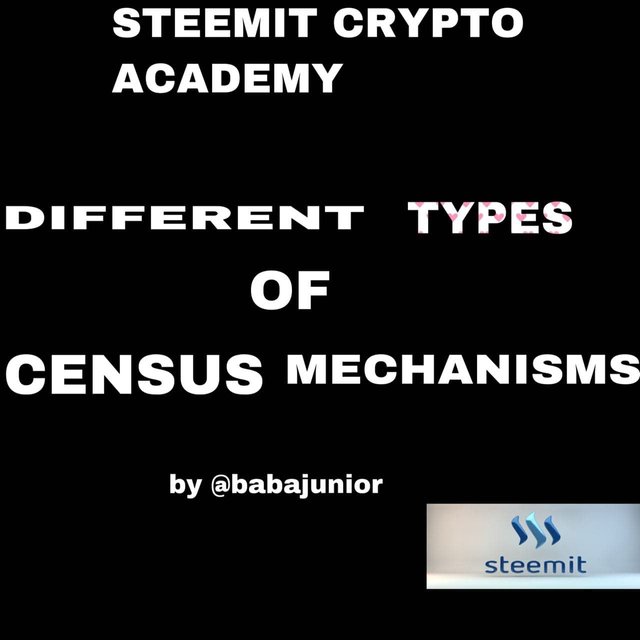Crypto Academy Season 3 Beginners' course - Homework Post Task 4 : Different Types of Consensus Mechanisms
Greetings CryptoAcadamy

(1) WHAT IS THE DIFFERENCE BETWEEN POW & POS? ADVANTAGES & DISADVANTAGES? WHICH ONE IS BETTER IN SCALING CAPACITY? EXAMPLES?
POW & POS DIFFERENCE
Before I go into detail about the differences between PoW and PoS, I believe it will be necessary to define PoW and PoS.
As a result, let me go over PoW and PoS one by one.
source
WHAT IS POW?
Proof of Work (PoW) refers to a decentralized consensus mechanism that necessitates a substantial amount of computer labor to answer complex mathematical riddles for malicious actors to avoid causing damage to the blockchain network. Proof of work (PoW) was developed to keep hackers out of the Bitcoin blockchain network. Bitcoin was the first cryptocurrency chain network to employ PoW. Following the concept's introduction in 2009, additional blockchain network companies jumped on board.
WHAT IS POS?
POS is an abbreviation for proof of stakes that says cryptocurrency miners may confirm block transactions based on their numbers of currencies. This indicates that the number of miners in currencies has determined their mining capacity. Proof of Stake (PoS) is a consensus method on the blockchain for validating transactions and adding new blocks. It was designed to take the place of Proof of Work (POW). Miners can only validate block transactions if they have a certain percentage of coins in proof of stake (PoS).
DIFFERENCE BETWEEN POW AND POS
Let's examine the distinctions between these two consensus processes now.
- Validation in Pow can only be done by a specialist because it necessitates a great deal of knowledge and abilities in the world of cryptocurrency, but in PoS, anyone may validate. It does not necessitate any talent or understanding, but it does necessitate a wallet full of coins.
- Proof of work (PoW) takes enormous quantities of energy, and running costs are more costly, whereas Proof of work (PoS) uses less energy and costs less.
- Proof of Work (PoW) can only handle a certain amount of transactions at once, but Proof of Stake (PoS) can handle a large number of transactions at once.
- Miners compare to solve complex problems using their computer processes power in Proof of Work (PoW), whereas miners are selected using an algorithm based on user stake in Proof of Stake (PoS).
ADVANTAGES AND DISADVANTAGES
ADVANTAGES OF PROOF -OF- WORK
- Proof of work transactions are always correct.
- Proof of Work is fast
- Everyone can prove themselves to be a miner
- Every miner who resolves hard math issues gets recompensed
DISADVANTAGES OF PROOF-OF-WORK
- High costs to establish and maintain a working consensus mechanism
- The environment is inhospitable because of the excessive energy usage in proof of work.
- It only handles a few transactions at a time.
ADVANTAGES OF PROOF-OF-STAKE
- It is less costly.
- Transaction verification takes less time.
- It can handle a greater number of transactions at once.
- Because it does not require sophisticated computers, proof of stake consumes less energy.
DISADVANTAGES OF PROOF OF STAKE
- Top stakeholders, who own 51 percent of the cryptocurrency, have control over the network's technological modifications.
- A single miner will be chosen and paid.
- Because of the cheap cost, proof of stake is insecure.
WHICH ONE IS BETTER IN SCALING CAPACITY? EXAMPLES?
PoS, in my opinion, is superior in scaling capacity than the other two consensus processes.
The rationale for this is that the PoS method provides several remedies to PoW scaling issues, such as excessive energy consumption, pollution, and transaction speed. PoS verifies transactions quickly, whereas PoW takes a lengthy time.
The following are some examples of networks that employ the PoW technique.
Bitcoin
Ethereum
Litecoin
The following are some examples of networks that employ the PoS technique.
Binance
Cardano
Polkadot.




Hello @babajunior , I’m glad you participated in the 4th task of the Beginner’s class at the Steemit Crypto Academy. Your grades in this task are as follows:
Recommendation / Feedback:
Thank you for submitting your homework. task 4. We hope to see the rest of your submissions.